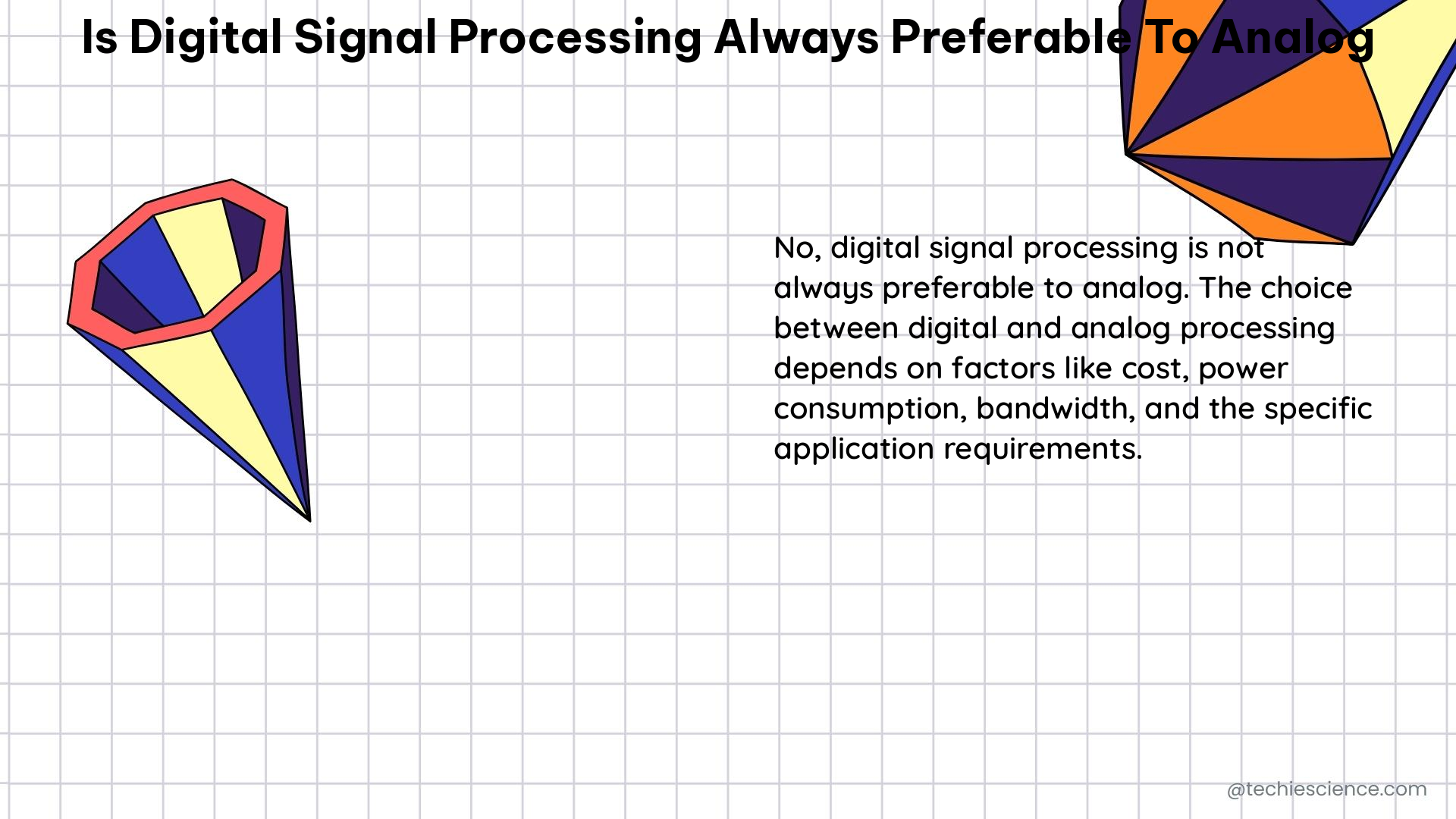Digital Signal Processing (DSP) and Analog Signal Processing (ASP) each have their own unique strengths and weaknesses, and the choice between the two depends on the specific requirements of the application. While DSP offers several advantages over ASP, it is not always the preferable option in every situation.
Advantages of Digital Signal Processing (DSP)
Resistance to Data Corruption
One of the primary advantages of DSP is its superior resistance to data corruption compared to ASP. Digital signals are transmitted as a series of 1s and 0s, whereas analog signals are transmitted as continuous waveforms. This means that digital signals are less susceptible to interference and noise, which can degrade the quality of analog signals. Digital signals can be easily detected and corrected, ensuring the integrity of the data.
Precision and Accuracy
Digital signals can be manipulated and processed with a high degree of accuracy, which is not possible with analog signals. DSP allows for the use of complex algorithms and signal processing techniques that can provide more precise and accurate results. This is particularly important in applications where precise measurements or calculations are required, such as in medical imaging, audio processing, and scientific instrumentation.
Storage and Retrieval of Signals
Another key advantage of DSP is the ability to store and retrieve digital signals. Digital signals can be stored on various digital media, such as hard drives, memory cards, or solid-state drives, and can be retrieved and processed at a later time. This is not possible with analog signals, which are transmitted in real-time and cannot be stored for later use.
Advantages of Analog Signal Processing (ASP)

Accurate Representation of Physical Phenomena
Analog signals provide a more accurate representation of changes in physical phenomena, such as sound, light, temperature, position, or pressure. Analog signals can capture the continuous nature of these physical phenomena, which can be important in certain applications, such as in sensor-based systems or audio recording.
Simplicity and Cost-Effectiveness
Analog signal processing circuits can be simpler and less expensive to design and manufacture than digital signal processing circuits. Analog circuits can also be more power-efficient than digital circuits, which can be important in battery-powered devices or applications where power consumption is a critical factor.
Intuitive Understanding
Analog signals are often more intuitive and easier to understand than digital signals, particularly for those who are more familiar with the behavior of physical systems. This can be advantageous in applications where the end-user needs to have a clear understanding of the signal processing being performed.
Technical Specifications
Digital Signal Processing (DSP)
DSP typically involves the use of specialized digital signal processors (DSPs) or microcontrollers with built-in DSP capabilities. These processors are designed to perform mathematical operations on digital signals quickly and efficiently. DSPs typically have a high clock speed, large amounts of memory, and specialized instruction sets for performing signal processing operations.
Analog Signal Processing (ASP)
ASP, on the other hand, typically involves the use of analog circuits, such as operational amplifiers (op-amps), filters, and other analog components. These circuits are designed to process analog signals in real-time, and can be simpler and less expensive than digital signal processing circuits.
Comparison of DSP and ASP
The choice between DSP and ASP depends on the specific requirements of the application. DSP offers advantages in terms of resistance to data corruption, precision and accuracy, and the ability to store and retrieve signals. However, ASP can provide a more accurate representation of physical phenomena, and can be simpler and more cost-effective in certain applications.
In some cases, a hybrid approach that combines both DSP and ASP may be the most appropriate solution, leveraging the strengths of each to meet the specific requirements of the application.
Conclusion
In conclusion, while DSP offers several advantages over ASP, it is not always the preferable option in every situation. The choice between the two depends on the specific requirements of the application, including factors such as the need for precision, the importance of accurate representation of physical phenomena, and the cost and power considerations. By understanding the strengths and weaknesses of both DSP and ASP, engineers can make informed decisions to select the most appropriate signal processing approach for their specific needs.
References
- Monolithic Power Systems, “Analog vs. Digital Signals: Uses, Advantages and Disadvantages,” https://www.monolithicpower.com/en/analog-vs-digital-signal
- Study.com, “Analog vs. Digital Devices | Overview, Differences & Examples,” https://study.com/learn/lesson/analog-vs-digital-devices-overview-differences-examples.html
- Wikipedia, “Quantization (signal processing),” https://en.wikipedia.org/wiki/Quantization_(signal_processing)
- Texas Instruments, “Analog vs. Digital Signal Processing,” https://www.ti.com/lit/an/spra439a/spra439a.pdf
- Analog Devices, “Analog vs. Digital Signal Processing,” https://www.analog.com/en/analog-dialogue/articles/analog-vs-digital-signal-processing.html

The lambdageeks.com Core SME Team is a group of experienced subject matter experts from diverse scientific and technical fields including Physics, Chemistry, Technology,Electronics & Electrical Engineering, Automotive, Mechanical Engineering. Our team collaborates to create high-quality, well-researched articles on a wide range of science and technology topics for the lambdageeks.com website.
All Our Senior SME are having more than 7 Years of experience in the respective fields . They are either Working Industry Professionals or assocaited With different Universities. Refer Our Authors Page to get to know About our Core SMEs.